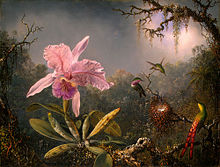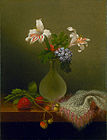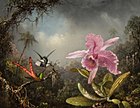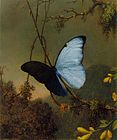Martin Johnson Heade
Martin Johnson Heade | |
|---|---|
Henry Morrison Flagler |
Martin Johnson Heade (August 11, 1819 – September 4, 1904) was an American
Heade was born in
Heade was not a widely known artist during his lifetime, but his work attracted the notice of scholars, art historians, and collectors during the 1940s. He quickly became recognized as a major American artist. Although often considered a Hudson River School artist, some critics and scholars take exception to this categorization. Heade's works are now in major museums and collections. His paintings are occasionally discovered in unlikely places such as garage sales and flea markets.
Childhood and early career
Heade was born in 1819 and was raised in Lumberville, Pennsylvania. Lumberville was a small hamlet, along the Delaware River in Bucks County, Pennsylvania.[2] Until the mid-1850s, his family ran what is now called the Lumberville Store and Post Office, the village's sole general store. The family spelling of the name was Heed.
Heade received his first art training from the folk artist Edward Hicks, who lived in nearby Newtown, and possibly also from Edward's cousin, Thomas Hicks.[2] Heade was painting by 1839; his earliest known work is a portrait from that year.[2] He traveled abroad and lived in Rome for two years. He first exhibited his work in 1841, at the Pennsylvania Academy of the Fine Arts in Philadelphia, and again in 1843 at the National Academy of Design in New York.[2] Heade began exhibiting regularly in 1848, after another trip to Europe, and became an itinerant artist until he settled in New York in 1859.[3]
Transition to landscape painting


Around 1857 Heade became interested in
Tropical subjects

Heade's interest in the tropics was piqued at least partly by the impact of
Salt marsh scenes

Heade's primary interest in
Later life and still lifes

Heade married and moved to
Heade and the Hudson River School
Art historians have come to disagree with the common view that Heade is a

The leading Heade scholar and author of Heade's catalogue raisonné, Theodore E. Stebbins, Jr., wrote some years after the 1987 exhibition, "Other scholars—myself included—have increasingly come to doubt that Heade is most usefully seen as standing within that school."
According to the Heade catalogue raisonné, only around 40 percent of his paintings were landscapes. The remaining majority were still lifes, paintings of birds, and portraits, subjects unrelated to the Hudson River School. Of Heade's
Heade had less interest in topographically accurate views than the Hudson River painters, and instead focused on mood and the effects of light. Stebbins wrote, "If the paintings of the shore as well as the more conventional compositions...might lead one to think of Heade as a Hudson River School painter, the [marsh scenes] make it clear that he was not."[5]
Legacy and collections
Heade was not a famous artist during his time, and for much of the first part of the 20th century was nearly forgotten.[2] A re-awakening of interest in 19th-century American art around World War II sparked new appreciation of his work. Heade's work in particular received critical attention with the exhibition in 1943 of his painting Thunderstorm On Narragansett Bay (1868), as part of the show "Romantic Painting in America" at the Museum of Modern Art.[2] Art historians have come to consider him one of the most important American artists of his generation. His work has inspired contemporary artists such as Renee McGinnis, David Bierk and Ian Hornak.
His works are in most major American museums, including the
In 1955, Robert McIntyre, art historian and director of the Macbeth Gallery, donated a cache of Heade's personal papers to the Archives of American Art, part of the Smithsonian Institution. These papers included, among other things, Heade's sketchbook, notes, and letters from his friend and fellow artist Frederic Edwin Church. In 2007, these papers were digitized and made accessible on the Web.[6]
In 1999 and 2000, Heade was the subject of a major exhibition organized by Theodore E. Stebbins, Jr. It traveled from the Museum of Fine Arts in Boston to the National Gallery of Art in Washington, ending at the Los Angeles County Museum of Art.[7]
In 2004, Heade was honored with a stamp from the
Discoveries of works by Heade
- Thunderstorm on Narragansett Bay, now in the collection of the Amon Carter Museum of American Art, Fort Worth, Texas, was originally discovered in an antiques store in Larchmont, New York, in 1943 by NYC art dealer Victor Spark.
- Magnolia Blossoms on Blue Velvet and Cherokee Roses, now in private collections, were purchased at an estate sale in Arizona for $60 in 1996. They sold at Christie's auction house later that year for $937,500 and $134,500 respectively.
- Two Magnolias on Blue Plush was originally purchased for $29 at a rummage sale by a Wisconsin man in 1989. It sold at Christie's auction house in 1999 for $882,500. It is now in the collection of James W. McGlothlin of Bristol, Virginia.
- Magnolias on Gold Velvet Cloth was used to cover a hole in the wall of an Indiana resident for years. The owner became curious about the value of the painting after playing an art-related board game, and verified its authenticity with a New York art gallery.[9] The Museum of Fine Arts in Houston purchased the work for $1,250,000 in 1999.
- An unnamed Heade salt marsh PBStelevision show, "Find!". It was purchased by a private collector, and is now on view at the Fogg Art Museum in Cambridge, Massachusetts.
- In 2004 a Florida woman was informed of the Heade discovery featured on "Find!" by her son, and inquired about a small 6 by 12 inch landscape that had hung in her living room. The painting, which her late husband had purchased for several dollars in St. Augustine in the 1970s, was authenticated as a late Heade marsh landscape. It sold at auction to an art dealer for $218,500.
- A painting was found in a Massachusetts attic in 2006 and consigned to a local auction in Fall River. The painting was authenticated by Dr. Theodore Stebbins, Jr., as a Heade, having been painted between 1883 and 1890 in St. Augustine, Florida. It sold for $198,000 on November 22, 2006.[citation needed]
Fakes
On the other hand, an unknown number of Heade's were faked. In 2012, Ken Perenyi (born 1947) disclosed in his book, Caveat Emptor how he forged numerous works purporting to be by Heade and other American masters. He avoided prosecution because he published his book after the statute of limitations had elapsed.[10]
Works
-
Portrait of a Man, 1840
-
Rocks in New England, 1855
-
Mary Rebecca Clark, 1857
-
Rhode Island Landscape, 1859
-
A Vase of Corn Lilies and Heliotrope, 1863
-
Hunters Resting, 1863
-
Sunrise in Nicaragua, 1869
-
Passion Flowers with Hummingbirds, 1870–1883
-
Orchid with Two Hummingbirds, 1871, Reynolda House Museum of American Art
-
Orchids and Hummingbirds, 1875–1890
-
Orchid and Hummingbird, 1880
-
Orchid and Hummingbird near a Mountain Waterfall, 1902
-
Florida River Scene: Early Evening, After Sunset, c. 1887–1900
-
On the San Sebastian River, Florida, 1883–1890
-
Sudden Showers, Newbury Marshes, c. 1865–1875
-
The Marshes at Rhode Island, 1866
-
Jersey Marshes, 1874
-
Sunset Over the Marshes, 1890–1904
-
Magnolia Grandiflora, 1885–1895
-
The Magnolia Blossom, 1888
-
Orchids and Spray Orchids with Hummingbird, about 1875–1890
-
Blue Morpho Butterfly, date unknown
-
Seascape: Sunset, date unknown
See also
- List of Hudson River School artists
- Ponce de Leon Artist Colony
References
- S2CID 191647373.
- ^ ISBN 0-8109-1811-0.
- ^ Biographical Note. Martin Johnson Heade papers, 1853–1904. Archives of American Art, Smithsonian Institution.
- ^ National Gallery of Art. "Martin Johnson Heade (American, 1819–1904)". Archived from the original on May 9, 2009. Retrieved January 9, 2012.
- OCLC 247135724.
- ^ "A Finding Aid to the Martin Johnson Heade Papers, 1853-1904, in the Archives of American Art". Smithsonian Institution. Retrieved May 22, 2022.
- ^ Knight, Christopher (May 29, 2000). "A Late Bloomer". The Los Angeles Times.
- ^ United States Postal Service Press Release, Art of Martin Johnson Heade is First-Class Choice for USPS Postage Stamp Archived 2007-12-07 at the Wayback Machine. July 22, 2004.
- ^ Dobrzynski, Judith H. (June 4, 1999). "Painting Packs a Million-Dollar Surprise". New York Times. Retrieved August 26, 2009.
- ISBN 978-1605983608.
Further reading
- Wilton, Andrew; Barringer, Tim (2002). American Sublime: Landscape Painting in the United States 1820–1880. Princeton: The Princeton University Press. ISBN 0-691-09670-8.
- Stebbins Jr., Theodore E. (2000). The Life and Work of Martin Johnson Heade: A Critical Analysis and Catalogue Raisonné. New Haven: Yale University Press. ISBN 0-300-08183-9.
- Stebbins Jr., Theodore E.; Comey, Janet L. (1999). Martin Johnson Heade. Boston: Museum of Fine Arts. OCLC 717533031.
- Benfey, Christopher (2008). A Summer of Hummingbirds: Love, Art, and Scandal in the Intersecting Worlds of Emily Dickinson, Mark Twain, Harriet Beecher Stowe, & Martin Johnson Heade. New York: Penguin Books. ISBN 978-1-59420-160-8.
External links
![]() Media related to Martin Johnson Heade at Wikimedia Commons
Media related to Martin Johnson Heade at Wikimedia Commons
- 218 paintings by Martin Johnson Heade
- White Mountain paintings by Martin Johnson Heade
- Martin Johnson Heade Biography: Hollis Taggart Galleries
- Pennarola, Francis G. "The Law and Martin Johnson Heade". Archived from the original on June 7, 2016.
- Heade Paintings
- Martin Johnson Heade papers on-line at the Smithsonian Archives of American Art
- Museo Thyssen-Bornemisza Biography and Works: Martin Johnson Heade
- American Paradise: The World of the Hudson River School, an exhibition catalog from The Metropolitan Museum of Art (fully available online as PDF), which contains material on Heade (see index)
- Martin Johnson Heade at Find a Grave

























